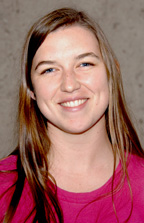
Two sets of hands raise a hive in place at the Häagen-Dazs Honey Bee Haven. (Photos by Kathy Keatley Garvey)
Thinking Outside the Box
How the Beehive Columns Went from Bee Boxes to Art
DAVIS—Diane Ullman, Donna Billick and Sarah Dalrymple are used to thinking outside the box.
Now they are thinking inside and outside the hive.
Visitors to the grand opening celebration of the Häagen-Dazs Honey Bee Haven, set from 10 a.m. to 2 p.m. on Saturday, Sept. 11, will see two columns of bee hives or “bee boxes” gracing the entrance to the half-acre bee friendly garden, located at the Harry H. Laidlaw Jr. Honey Bee Research Facility, University of California, Davis.
“They’re fantastic,” said bee breeder-geneticist Susan Cobey. “They’re beyond fantastic—the art work is awesome. Not only is the quality of artwork highly impressive, the coverage and accuracy of the honey bee life cycle and activities depicted are extremely well done.”
The colorfully painted bee hives are the work of the UC Davis Art/Science Fusion Program, co-founded and co-directed by Ullman and Billick. Ullman is an entomology professor and associate dean for undergraduate academic programs at the College of Agricultural and Environmental Sciences, and Billick is a noted artist who holds a bachelor’s degree in genetics and a master’s degree in fine arts.
 Dalrymple (left), a UC Davis entomology graduate student who studies with major professor Rick Karban, served as the teachers’ assistant for the program’s Graphics and Communications Studio section.
Dalrymple (left), a UC Davis entomology graduate student who studies with major professor Rick Karban, served as the teachers’ assistant for the program’s Graphics and Communications Studio section.
As part of their research, the students enrolled in the class visited the Laidlaw facility, learning about bees from Cobey and staff research associate-beekeeper Elizabeth Frost.
“From my view, watching this come together has been a highlight, as the students asked their numerous questions seeking accuracy and sought the experience of opening a colony and observing bees in their numerous duties,” Cobey said. “The delight and amazement of students holding a frame of brood, watching a new bee emerge from her cell, feed larvae or pack in pollen for first time, is also is a thrill for me.”
Each sculpture is stacked with seven real bee hives, so real that curious Laidlaw bees try to enter them. One column depicts life inside the hive, and the other column, life outside the hive. Among the images: a queen bee laying eggs, nurse maids caring for the brood, and foragers collecting nectar, pollen, propolis and water.
As the teacher’s assistant of the Graphics and Communications Studio, Dalrymple led students through painting exercises and helped them come up with the two major themes of the columns: honey bee pollination and life inside the hive. “Each student came up with designs for two sides of the bee boxes and then painted them,” Dalrymple said. “I strived to let students come up with their designs independently, but I was there to give direction when they had trouble doing so.”
Dalrymple provided feedback on the designs and offered suggestions for making them more scientifically accurate or aesthetically pleasing. In addition, she painted one side of a box in the "Life Inside the Hive" column and made final design decisions, such as what order the boxes should be in the column.
“Diane Ullman and Donna Billick were incredibly helpful, offering invaluable suggestions along the way, and ultimately installing the pieces in the Honey Bee Haven,” Dalrymple said. Local artist Melissa Chandon also led the students through a painting exercise during one studio session.
“I couldn't have gotten through the quarter without each of their help,” Dalrymple said, adding that she is “incredibly proud of the work” the students did.
“The outcome is simultaneously educational and beautiful,” she said. “The artwork depicts the intricate division of labor among different honey bee castes and the pollination services that honey bees provide to important crops and wildflowers. I hope it will serve as a focal point and source of information about honey bees for garden visitors.”
Although visitors to the haven wouldn’t know it, only a handful of the students came in with a lot of painting experience. “Most of them had done very little painting or none at all prior to this class,” she said. “This project was very empowering and made the students feel a real connection to the UC Davis campus. I think those are some of the most positive outcomes of the public art projects created in Entomology 1.”
Entomology 1, “Art, Science and the World of Insects,” is the centerpiece course of the UC Davis Art/Science Fusion Program.
The half-acre bee friendly garden, open year around, includes a 6-foot-long honey bee, created by Billick and funded by Wells Fargo. Ceramic tiles on the bench below the bee were created by undergraduate students in a freshmen seminar for Davis Honors Challenge students; community members; and sixth grade students at Korematsu Elementary School.
The Laidlaw facility is located on Bee Biology Road, off Hopkins Road, on the western end of the campus. To reach the grounds, go west on Hutchinson Drive for about a mile, turn left on Hopkins Road, and then a left on Bee Biology Road.
More information on the grand opening is at http://archive.beebiology.ucdavis.edu/HAVEN/havenopening.html

Diane Ullman, Donna Billick and Eric Mussen install a beehive column.
Related links:
More than 50 Bee Species Found in Haven: Robbin Thorp
Artist-Scientist Donna Billick Creates Giant Bee Sculpture
Blending Art With Science: UC Davis Art/Science Fusion Program (See More Photos)
Häagen-Dazs Educational Website
Eric Mussen on Colony Collapse Disorder (Video)
Directions
Winning design:
Sausalito team plan (PDF, 21 pages)